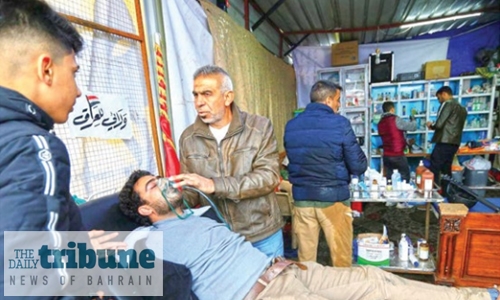12 dead, hundreds wounded as protesters clash with Iraq security forces
Twelve people were killed and 230 others injured in protests in Iraq over the past three days, the Independent High Commission for Human Rights of Iraq said yesterday. Iraqi security forces fired teargas and live bullets in renewed clashes with protesters in Baghdad and other cities, protesters said.
The security forces tried to clear sit-in camps across the country and fired live rounds in the air after protesters resisted with petrol bombs and stones. At least 14 protesters were wounded in the capital and at least 17 were wounded in Nassiriya in the south, medical sources said. The furore began overnight on Friday and the early hours of Saturday morning, when Iraqi anti-riot forces advanced towards Tahrir Square.
They pushed past massive concrete T-walls to Al Khilani avenue, which borders the entrance to the square and set tents—many of which were used to treat the wounded—aflame. “I am a victim,” said Mohamed Al Seif, a young medic who volunteered at one of the tents destroyed by the security forces. He knelt sweeping up the still-smoking ashes of his tent as he described the “boxing style” beating by security forces. Mr Al Seif said the forces arrived around 10 am.
“There were five us inside the tent, they beat all of us. They came aiming at us with live bullets,” he recalled. It wasn’t just Baghdad that suffered. Also on Saturday, following a call from influential Shia cleric Moqtada Al Sadr to end to protests, remaining demonstrators faced a renewed crackdown. Security forces advanced on protest centres across Iraq’s Southern provinces, burning tents and violently dispersing protesters.
The attacks left at least four dead, three in the Southern City of Nasiriyah and one in Baghdad. They come after days of increasing state violence against protesters on Baghdad’s Mohammed Qassem highway. Since the very start of the protests in October 2019, Baghdad’s Tahrir Square has functioned as a second home for protesters.
Young men and women created a mini-city including libraries, brightly painted walls, and kitchen set-up to keep demonstrators well nourished. As the protests lengthened beyond four months, protesters took over more space, branching off from Tahrir Square to occupy three bridges, two squares, and in recent weeks the Mohammed Qassem Highway, a key artery for Baghdad traffic.
Related Posts

